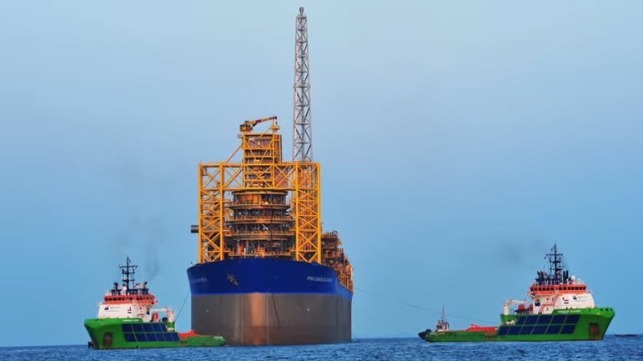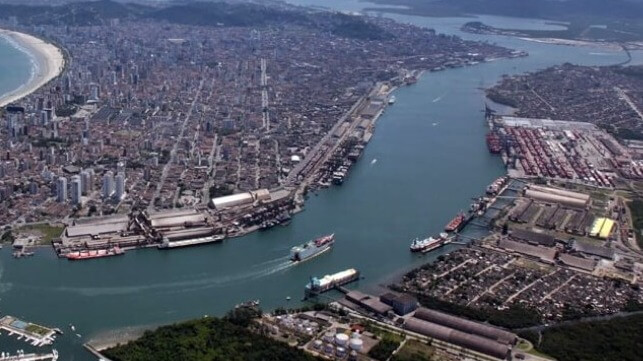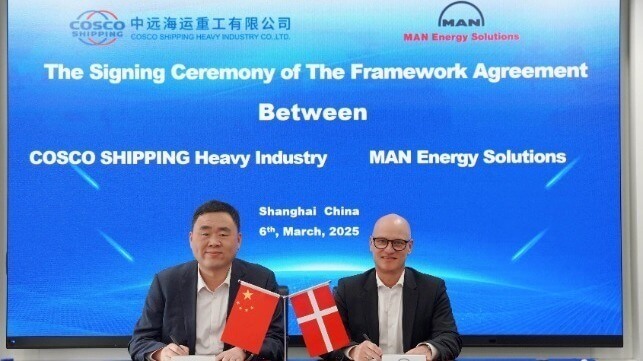Brazil's Offshore Oil Sector is Fueling China

Last year, oil overtook soy as Brazil’s main export for the first time since 2012. According to trade data published by the government, foreign oil sales totalled almost USD 45 billion in 2024, passing soy’s USD 43 billion. The value of Brazil’s crude oil exports has more than doubled in the past five years, and has close to quadrupled in the past decade.
China is driving this demand. According to Brazilian government data, China received 44% of Brazil’s crude oil exports in 2024, followed by the US (13%) and Spain (11%). In the past decade, the value exported to the Chinese market has also grown by almost five times.
In tonnes, China’s relevance remains significant, though less pronounced. In 2024, it purchased 44% of the oil exported by Brazil. But although China tripled its demand for Brazilian oil over the past decade, its consumption is similar to that of five years ago.
According to experts, this trend could become more pronounced in the short term, due to US President Donald Trump’s initiation of a trade war with China. The Asian country retaliated in February by imposing a 10% tariff on oil from the US – the source of 2% of its oil imports in 2024 – and may likely increasingly turn to providers such as Brazil.
Brazil’s growing oil exports are casting a shadow on national climate ambitions, as well as several environmental and clean energy cooperation agreements it has penned with China. Furthermore, Brazil is preparing to host November’s COP30 climate summit in the Amazonian city of Belém; in March, President Luiz Inácio Lula da Silva said the country “is at the forefront of a global ethical assessment to raise climate ambition”. But in recent weeks, the government has also been increasingly pushing for oil exploration in Brazil’s ecologically sensitive Foz do Amazonas, the mouth of the Amazon river.
This insistence on fossil fuels is raising scepticism around Brazil’s green promises.
‘Brazil is reliable for China’
China imports more crude oil than any other country. According to the International Energy Agency, this demand has grown over recent decades mainly due to China’s massive investments in industry and infrastructure, as well as its population growth and economic development. Russia and Saudi Arabia provided the bulk of China’s crude oil imports in 2023; Brazil ranked sixth.
“Brazil is a reliable country for China,” says Tulio Cariello, director of content and research at the Brazil-China Business Council (CEBC). “It’s a major producer, and has a lot of research, development and stability. The country enjoys a privileged geopolitical situation, as it is far from disputed regions.”
According to Brazilian government trade data, China has also exponentially increased its imports of refined fuel from Brazil: the amount spent climbed from USD 88 million to USD 609 million between 2023 and 2024. Dialogue Earth consulted Igor Celeste, a market intelligence manager at the Brazilian Trade and Investment Promotion Agency (ApexBrasil): “Although it’s a more incipient product on the Chinese import list, we believe – given the dynamics of growth – that there may be more opportunities or demand in the future.”
André Leão, a researcher at the Institute for Strategic Studies on Oil, Natural Gas and Biofuels (Ineep) in Rio de Janeiro, says the intensification of the rivalry between the US and China after Donald Trump’s victory could prompt Brazil to further expand its exports to China.
“From a political point of view, Brazil is also likely to exhibit a tendency to distance itself from the US, although [Brazilian] diplomacy is adopting a cautious stance. This creates an opportunity to strengthen relations with China,” explains Leão.
China is a major consumer of oil and coal and maintains a predominantly fossil fuel-based energy mix. However, China is also rapidly advancing in its transition to cleaner energy sources: national CO2 emissions are expected to peak later this year. Sinopec, the largest Chinese oil refiner, estimates that refining will peak in 2027 as domestic consumption of diesel and petrol falls.
Despite these circumstances, analysts expect Brazil’s oil exports to the Chinese market to continue growing. Cariello says Brazil’s supply will remain crucial to China, and while reducing their dependence on this market is something that “companies in the sector are aware of”, it will only occur “in the distant future”.
Financing the energy transition
Brazil finds itself holding contradictory roles as both an exporter of growing volumes of oil and a leader on climate action. According to analysts, Brazil can reconcile these positions by maintaining its defence of “common but differentiated capacities and responsibilities”. This principle, enshrined under the United Nations’ climate convention, holds that developing countries must reduce their greenhouse gas emissions, but without assuming the same targets as developed countries.
“One of the ways to reconcile this is to argue that the resources needed to make the transition come from oil exploration itself,” adds Leão.
In 2024, the Energy Research Company (EPE), which supports Brazil’s energy planning, published a study highlighting the oil industry’s strategic role in energy security and investment. The institution argues that oil sustains Brazil’s economic development and its citizens’ quality-of-life standards. It also argues that oil will continue to meet demand amid global uncertainties around the pace of fossil fuels’ decline, and preserve jobs while the workforce adapts.
“Even in the most ambitious energy-transition scenarios, we haven’t reached zero oil consumption,” says Heloísa Borges Esteves, EPE’s director of oil, gas and biofuels studies. “The oil and gas industry needs to collaborate with the transition, financing the technologies we need.”
Researchers consulted by Dialogue Earth say they recognise the country’s dependence on oil, especially in the transport sector. But they criticise the government’s lack of mechanisms linking oil revenues to investments in clean sources, or to monitor such allocations.
Dialogue Earth spoke to Shigueo Watanabe Jr, a researcher and physicist specialising in climate change at Climainfo, a São Paulo-based non-profit dedicated to climate change news and research. “It’s impossible to say, ‘This item here is from royalties that the federal government earns from selling oil, and this money is being used for wind energy or public transport,’” he points out. “Without designating where the money is going, and without metrics that allow us to check whether this plan is being implemented, this story of financing the energy transition is a fantasy.”
Oil until when?
Tensions over oil exploration in Brazil have intensified in recent weeks, especially in relation to Foz do Amazonas. The project is causing divisions even within the government itself.
The oil firm Petrobras is seeking to move forward with studies to assess the viability of exploring the area. The state-owned company argues that Foz do Amazonas is crucial to keeping the country’s oil reserves stable. However, the government’s environmental agency, Ibama, recommends rejecting the project’s environmental licence. It cites potential harm to mangroves and sensitive Amazonian reefs, as well as to coastal populations.
President Lula has come out emphatically in favour of this exploration. Faced with the possibility of Ibama’s third rejection of the project, Lula says the agency “seems to be against the government”. Brasília is now reportedly considering replacing Ibama’s management.
Amid this impasse, some observers are highlighting the lack of concrete proposals to reduce Brazil’s fossil fuel dependence. Watanabe Jr says the country will continue to exploit oil unless there is “a revolution – which is unlikely”. But he adds that the government “needs to have a plan to stop burning oil at some point, as soon as possible”.
Currently, the EPE has an energy expansion plan up to 2050 that does not include clear carbon-neutrality scenarios. The government’s Climate Plan, conceived as a pathway for climate change mitigation through to 2035, has been in preparation since 2023. Its first part is due for publication this year. Until then, says Watanabe Jr, Brazil still does not have a clear plan to reduce its dependence on oil, whether for domestic consumption or export.
“Brazil today extracts more or less three million barrels of oil a day. We consume between one million and two million, and that million that’s left over, we export,” explains Watanabe Jr. “They export to make money; they get some royalties. But do you need to export all that oil? Probably not. It’s a hyper-contradiction to say, ‘let’s take care of the climate’, and at the same time increase emissions in order to have money.”
André Duchiade is a Brazilian journalist and translator based in Rio de Janeiro. He has worked for O Globo and Época and his work has been published in several national and international media, including The Scientific American, Sumaúma, The Intercept Brasil and Agência Pública.
This article appears courtesy of Dialogue Earth and may be found in its original form here.
The opinions expressed herein are the author's and not necessarily those of The Maritime Executive
Brazil’s Ag Sector Plans for Export Boom as China Pivots Away from U.S.

The re-ordering of global trade, escalated by the astronomical tariffs between the U.S and China, has left some countries with significant export advantages. Brazil is already showing signs as an early winner, with its port sector reporting increased demand. A strong preference for the Brazilian soybean has started to appear in China, historically a large-scale buyer of American soy.
According to Reuters, China is expected to receive about 3 million tons of U.S soybeans in April-May, which its state stockpiler Sinograin purchased earlier this year. However, due to China’s new 125 percent tariffs on American goods, the shipment is likely to attract higher duties and possibly sell at a discount due to cheap competition from beans from Brazil.
“The pressure of the soy crushing margins on Chinese industries will likely change the country’s import dynamics. As these margins come under negative pressure, China tends to slow down the pace of imports and rely on domestic stockpiles- as seen in the previous trade war in 2018,” said the Brazilian National Association of Cereal Exporters (Anec) in its monthly report this week.
Anec predicts a potential export boom for the Brazilian soy this year of up to 110 million tons, representing a historic record for Brazil. In the first quarter of 2025, Brazil has already recorded shipments of about 27 million tons, a four percent increase compared to last year. Currently, China accounts for 77 percent of Brazilian soy exports.
The uptick in export volumes is also visible in the port sector data, with Brazilian ports moving 12.4 million tons of containers in February- the highest volume ever recorded, according to the National Agency for Waterway Transportation (Antaq). This figure represents a 9.26 percent increase compared to the same period in 2024. Of the total, around 70 percent (8.6 million tons) was from long-haul shipping, while the remaining 30 percent (3.7 million tons) was from coastal shipping (cabotage). Some of the major commodities behind the increase include corn, bauxite and fertilizers. Other shipments which rose by a significant measure include poultry products. Brazil’s exports of fresh and processed poultry reached 476,000 tons in March, up 19 percent from a year earlier, according to the Brazilian Animal Protein Association (ABPA).
In anticipating higher export volumes, some ports are already investing in additional capacity as well as diversifying operations. Porto do Acu, located in the state of Rio de Janeiro and Brazil’s top oil export port, has said that the tariff-induced distortions in global trade has given the port an incentive to expand facilities for agricultural and mineral commodities.
“When threats started, demand started to rise. We are in a really good position here,” João Braz, the port’s logistics director told Bloomberg.
Brazil’s agricultural shipments are also a factor in China’s interests in the Panama Canal. Chinese economist Li Xunlei has called for improving government ties in the Central American country in order to ensure strategic access to the waterway for China’s food shipments; 90 percent of the Brazil-to-China soy trade passes through the canal, he said in a recent paper.
Top image: Port of Santos (Agencia CNT / CC BY 2.0)
COSCO Extends Strategic Cooperation

[By: MAN Energy Solutions]
At a recent ceremony in China, MAN Energy Solutions signed a framework agreement with COSCO Shipping Heavy Industry Co., Ltd. (CHI) regarding their future cooperation on decarbonisation retrofit projects.
Michael Petersen – Senior Vice President, Head of PrimeServ Denmark – signed the agreement on behalf of MAN Energy Solutions, with Guo Zhiqiang – Deputy General Manager, CHI Commercial Headquarters – doing so for CHI.
Guo Zhiqiang said: “I am pleased to announce that CHI and MAN Energy Solutions, having served shared clients in their respective domains, are now forging a closer collaboration in vessel decarbonisation. Starting today, our integrated one-stop solutions will inject fresh impetus into the green transition of the global maritime industry.”
Petersen said: “This frame agreement facilitates MAN Energy Solutions’ partnership with CHI, one of the largest repair-yard groups in the world. The agreement means that we can join forces on many future projects to ensure the decarbonisation of the existing commercial fleet worldwide. Today, there are some 4,500 vessels globally with the potential to benefit from changing their current bunker fuel to more environmentally-friendly options. We look forward to working with CHI to deliver new decarbonisation solutions to the maritime industry.”
The new framework agreement provides for the retrofitting of existing ships to operation on new alternative fuels like methane, methanol and ammonia – all fuels that can be produced in a sustainable way through power-to-X processes. MAN Energy Solutions will provide advanced engine-retrofit technology and digital energy-efficiency solutions, while CHI will leverage its rich EPC (Engineering, Procurement, and Construction) experience in large-scale ship modification projects.
With five ship-repair yards, CHI has the capacity to repair and modify approximately 1,500 ships annually. This collaboration will integrate MAN PrimeServ’s cutting-edge, dual-fuel engine technology with CHI's repair and modification capabilities to decarbonise the merchant fleet globally.
MAN Energy Solutions views the new agreement as a natural development stemming from the companies’ strong relationship. In this respect, MAN Energy Solutions and CHI are already working together on two major projects for two world-leading container-ship owners.
The products and services herein described in this press release are not endorsed by The Maritime Executive.
No comments:
Post a Comment